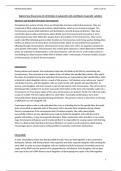Essay
Unit 11 LA: B (Explore how the process of cell division in eukaryotic cells contributes to genetic variation)
- Course
- Institution
This assignment has achieved DISTINCTION grade and was written well where it contains all of the necessary contents such as Structure and function of human chromosomes, centromeres, chromatids, autosomes, sex chromosomes, homologous, non - homologous, microscopic slides from the stages of mitosis a...
[Show more]



